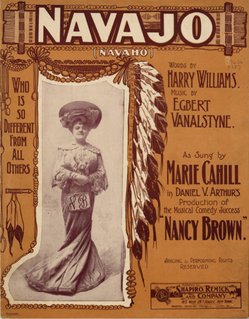This is a list of notable events in music that took place in the year 1909.
This is a list of notable events in music that took place in the year 1906.

Jean Schwartz was a Hungarian-born American songwriter.
Fred Fisher was a German-born American songwriter and Tin Pan Alley music publisher.
Howard Johnson was a song lyricist. He was inducted into the Songwriters Hall of Fame in 1970.
Jack Selig Yellen was an American lyricist and screenwriter. He is best remembered for writing the lyrics to the songs "Happy Days Are Here Again", which was used by Franklin Roosevelt as the theme song for his successful 1932 presidential campaign, and "Ain't She Sweet", a Tin Pan Alley standard.

Egbert Anson Van Alstyne was an American songwriter and pianist. Van Alstyne was the composer of a number of popular and ragtime tunes of the early 20th century.

William Austin Dillon was an American songwriter and Vaudevillian. He is best known as the lyricist for the song "I Want A Girl " (1911), written in collaboration with Harry Von Tilzer. It can be heard in Show Business (1944) and The Jolson Story (1946). He was born in Cortland, New York and performed at some point in Vaudeville with his brothers John and Harry. He billed his own act as the "man of a thousand songs".
Theodore F. Morse was an American composer of popular songs.
Edgar Leslie was an American songwriter.
Clarence Wainwright Murphy, also known as Charles William Murphy, C.W. Murphy and C. Murphy, (1875–1913) was a prolific British composer of music hall and musical theatre tunes, perhaps best known for the song "Has Anybody Here Seen Kelly?" with lyrics by Will Letters (1908). In 1926, "Has Anybody Here Seen Kelly?" was made into an animated short of the same title directed by Dave Fleischer, and in 1928 into a feature film directed by William Wyler. The song was also performed in the 1943 film Hello Frisco, Hello. With frequent collaborator Dan Lipton (1873–1935) he also wrote "My Girl's a Yorkshire Girl", mentioned by James Joyce in his novel Ulysses and also turned into a 1909 short sound film of the same name. Another song, "Little Yellow-bird", written with lyricist W. Hargreave, can be seen performed by Scottish comedian Charlie Naughton in the 1938 film Alf's Button Afloat and by Angela Lansbury in the 1945 film The Picture of Dorian Gray and again by Lansbury in the 1985 episode "Sing a Song of Murder" from her TV series Murder, She Wrote.

Samuel Howard Stept was an American songwriter who wrote for Broadway, Hollywood and the big bands. He became known simply as Sam Stept or Sam H. Stept — he rarely used his full middle name.
Bob Rothberg was a Tin Pan Alley songwriter and lyricist. ASCAP 1936. Educ: New York public schools 1915; DeWitt Clinton High School, New York 1919; accountancy and law, New York Law School, Bachelor of Laws 1928. Educated in music and violin with private instructors. Rothberg is interred at United Hebrew Cemetery on Staten Island.

"Pride Of The Prairie" is a popular song written in 1907 with music by George Botsford and lyrics by Henry J. Breen. The lyrics tell of a cowboy's love for Mary, the "Pride of the Prairie". The chorus is:

"Blue Feather" is a popular song written in 1909 with music by Theodore F. Morse and lyrics by Jack Mahoney. In the song the singer is expressing his love for sweet Blue Feather. The chorus is:

"Sun Bird" is an intermezzo composed by Kerry Mills in 1908. Thurland Chattaway wrote lyrics that appear in some later publications. The chorus is a love song from an Indian warrior to Sun Bird, an Indian maiden:

"Golden Arrow " is popular song published both as an intermezzo two-step and a ballad in 1909. The music was composed by Egbert Van Alstyne, with lyrics added by Harry Williams. The ballad is a love story between the unnamed son of a Chief Arrow-Bow and a maiden named Golden Arrow, both of the Sioux nation in Idaho.

Joseph Edgar Howard, known as Joe Howard was a Broadway composer, lyricist, and librettist. A famed member of Tin Pan Alley along with wife and composer Ida Emerson as part of the song-writing team of Howard and Emerson, his hits included "Hello! Ma Baby" and Broadway musicals like "I Wonder Who's Kissing Her Now?".
Harry David Kerr was an American songwriter, lyricist, author, and lawyer. Kerr became active in music at age 15 (1895). The practice of law had been his prime avocation until 1920, when he decided to focus on songwriting. But he still continued to use his legal training in music. In 1922, while living in New York City, Kerr prepared the incorporation documents for the American Society of Composers, Authors and Publishers (ASCAP), of which he had become one of 90 charter members at its founding in 1914.









